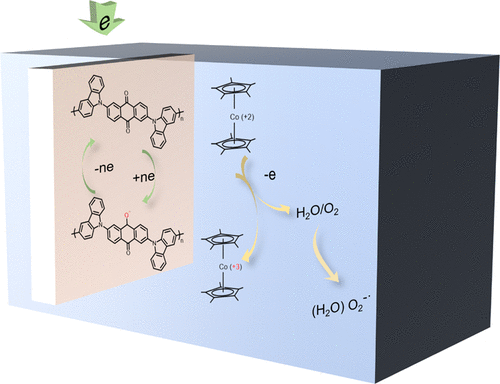当前位置:
X-MOL 学术
›
ACS Appl. Mater. Interfaces
›
论文详情
Our official English website, www.x-mol.net, welcomes your feedback! (Note: you will need to create a separate account there.)
Enhanced Long-Term Stability of Organic Electrode Materials by a Trap Filler Strategy
ACS Applied Materials & Interfaces ( IF 9.5 ) Pub Date : 2021-10-14 , DOI: 10.1021/acsami.1c14286 Manlin Zhao 1 , Huanhuan Zhang 1 , Yuguang Ma 1, 2
ACS Applied Materials & Interfaces ( IF 9.5 ) Pub Date : 2021-10-14 , DOI: 10.1021/acsami.1c14286 Manlin Zhao 1 , Huanhuan Zhang 1 , Yuguang Ma 1, 2
Affiliation

|
The sensitivity of organic electrode materials to water and oxygen has long been the bottleneck of their further development. The residual and penetrative water and oxygen in electrochemical cells form electron traps that trigger irreversible side reactions, which is detrimental to their long-term stability. A trap filler strategy by introducing molecules with low ionization energy in a cell, bis(pentamethylcyclopentadienyl)cobalt(II) (DMC) as an example, is demonstrated to deactivate traps spontaneously by donating electrons to traps without causing undesirable reactions with electrode materials. The electrode materials BthCz and AQCz, with lowest unoccupied molecular orbital levels above or near the electron traps (−3.6 to −3.8 eV), exhibit conspicuous stability increment of 68.6 and 26.3%, respectively, with the optimized DMC concentration of 5 × 10–4 M in acetonitrile electrolyte.
中文翻译:

通过陷阱填料策略增强有机电极材料的长期稳定性
有机电极材料对水和氧气的敏感性长期以来一直是其进一步发展的瓶颈。电化学电池中残留和渗透的水和氧气形成电子陷阱,引发不可逆的副反应,不利于电池的长期稳定性。通过在细胞中引入低电离能分子的陷阱填料策略,以双(五甲基环戊二烯基)钴(II)(DMC)为例,证明了通过向陷阱提供电子而自发地停用陷阱,而不会引起与电极材料的不良反应。电极材料 BthCz 和 AQCz 在电子陷阱上方或附近具有最低的未占据分子轨道能级(-3.6 至 -3.8 eV),分别表现出 68.6% 和 26.3% 的显着稳定性增量,–4 M 在乙腈电解液中。
更新日期:2021-10-27
中文翻译:

通过陷阱填料策略增强有机电极材料的长期稳定性
有机电极材料对水和氧气的敏感性长期以来一直是其进一步发展的瓶颈。电化学电池中残留和渗透的水和氧气形成电子陷阱,引发不可逆的副反应,不利于电池的长期稳定性。通过在细胞中引入低电离能分子的陷阱填料策略,以双(五甲基环戊二烯基)钴(II)(DMC)为例,证明了通过向陷阱提供电子而自发地停用陷阱,而不会引起与电极材料的不良反应。电极材料 BthCz 和 AQCz 在电子陷阱上方或附近具有最低的未占据分子轨道能级(-3.6 至 -3.8 eV),分别表现出 68.6% 和 26.3% 的显着稳定性增量,–4 M 在乙腈电解液中。



























 京公网安备 11010802027423号
京公网安备 11010802027423号